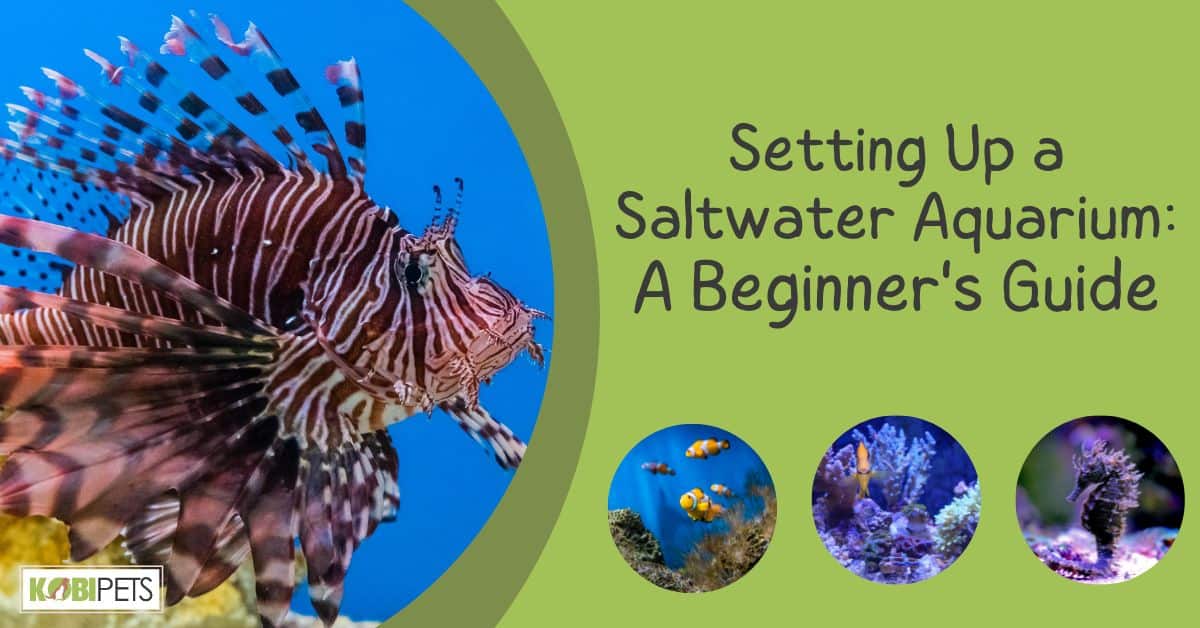
A saltwater aquarium is an incredibly rewarding and fulfilling hobby that can bring color, beauty, and tranquility to your home. With the right equipment, knowledge, and dedication, it’s easy to create a thriving environment for vibrant fish and invertebrates.
This guide provides a comprehensive overview of setting up a saltwater aquarium as well as tips and tricks to help you get started. Take the plunge and learn how to set up a saltwater aquarium that’s sure to fascinate hobbyists of all levels.
Benefits of Owning a Saltwater Aquarium
Owning a saltwater aquarium is a rewarding experience due to the wide variety of marine life that can be housed in them. In creating the perfect environment for these fish, invertebrates, and coral species, saltwater aquariums offer an aesthetically pleasing opportunity to contemplate the beauty of nature from the comfort of home.
As well as providing an interesting conversation starter that can possibly lead to creating meaningful connections between friends, family or coworkers, there are numerous scientific benefits to owning a saltwater aquarium. It encourages the responsible purchase and handling of tropical fish species while introducing basic concepts of general biology related to their care and maintenance.
Saltwater aquariums furthermore provide an excellent opportunity to track changes in water parameters such as levels of nitrates and other chemicals over time. The calming presence of both freshwater and marine life forms also makes it a great tool for mindfulness meditation.
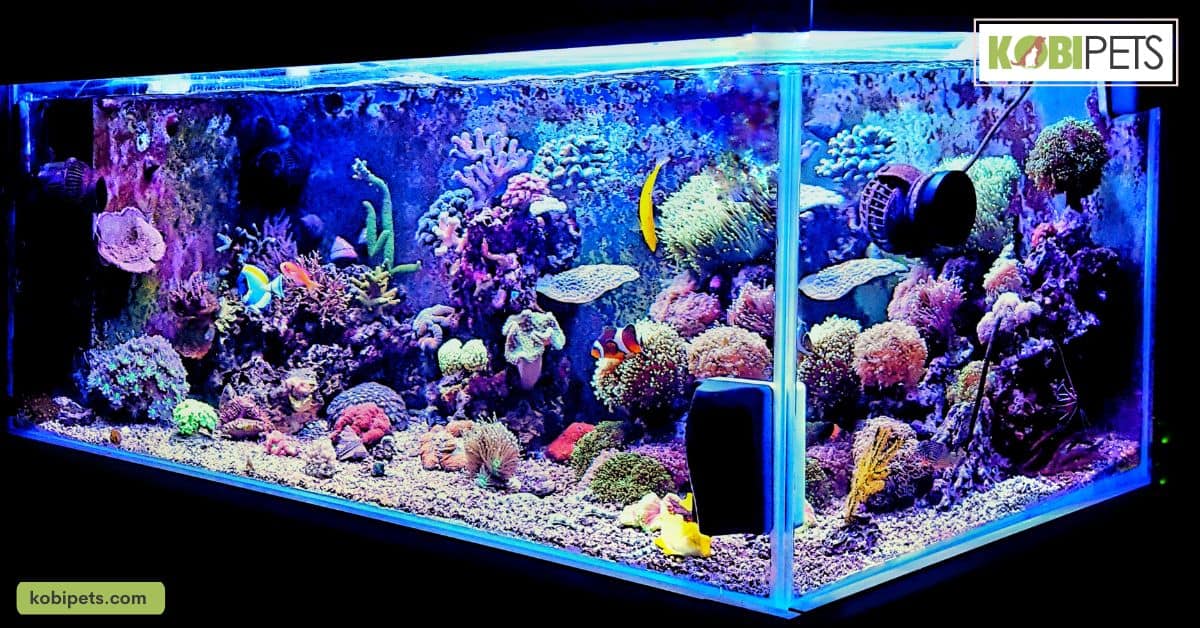
Equipment and Supplies
When setting up a saltwater aquarium, there are several pieces of equipment and supplies that are necessary for maintaining a healthy environment for your inhabitants. Here is a list of the most important items you will need, along with a brief explanation of their function:
| Equipment & Supplies | Function |
| Tank | This is the main container for your aquarium. The size and type of tank will depend on the type of aquarium you want to set up and the inhabitants you plan to add. |
| Lighting | Proper lighting is essential for the growth and health of coral and other photosynthetic organisms in a reef tank, and it also enhances the appearance of the tank. |
| Filtration system | A filtration system is necessary to keep the water in your tank clean and clear. There are several types of filters that can be used in a saltwater aquarium, including power filters, canister filters, and protein skimmers. |
| Substrate | This is the material that is placed on the bottom of the tank to provide a natural-looking environment for the inhabitants. Common types of the substrate include crushed coral, aragonite, and sand. |
| Water heater | A water heater is necessary to maintain the proper water temperature in the tank. The temperature will vary depending on the type of inhabitants you have. |
| Hydrometer/ Refractometer |
These tools measure the specific gravity and salinity of the water in your tank. Maintaining the proper specific gravity and salinity is essential for the health of your inhabitants. |
| Test kits | These are used to test the water in your tank for things like pH, ammonia, nitrite, and nitrate levels. Regular testing is necessary to ensure that the water conditions in the tank are appropriate for your inhabitants. |
| Salt Mix | The salt mix is used to create the appropriate salinity levels in the tank water. |
| Protein Skimmer | Protein skimmers are filtration devices that help remove dissolved organic waste products from the water. |
| Power Head | Powerheads are used to create water movement and circulation in the tank, which is important for the overall health of the inhabitants. |
| Thermometer | A thermometer is used to measure the temperature of the water in the tank. |
Overall, setting up a saltwater aquarium can be an incredibly rewarding and fulfilling hobby when done correctly. With the right equipment, knowledge, and dedication you can create a thriving environment for vibrant fish and invertebrates.
Tank Preparation
Tank preparation is a crucial step when setting up a saltwater aquarium. It involves cleaning the tank and adding substrate, rocks, and decorations to create an aesthetically pleasing environment. This process ensures that the water in your tank is healthy and free of contaminants or pollutants. Properly preparing your tank will also help maintain proper water parameters for your inhabitants, such as pH, alkalinity, and salinity.
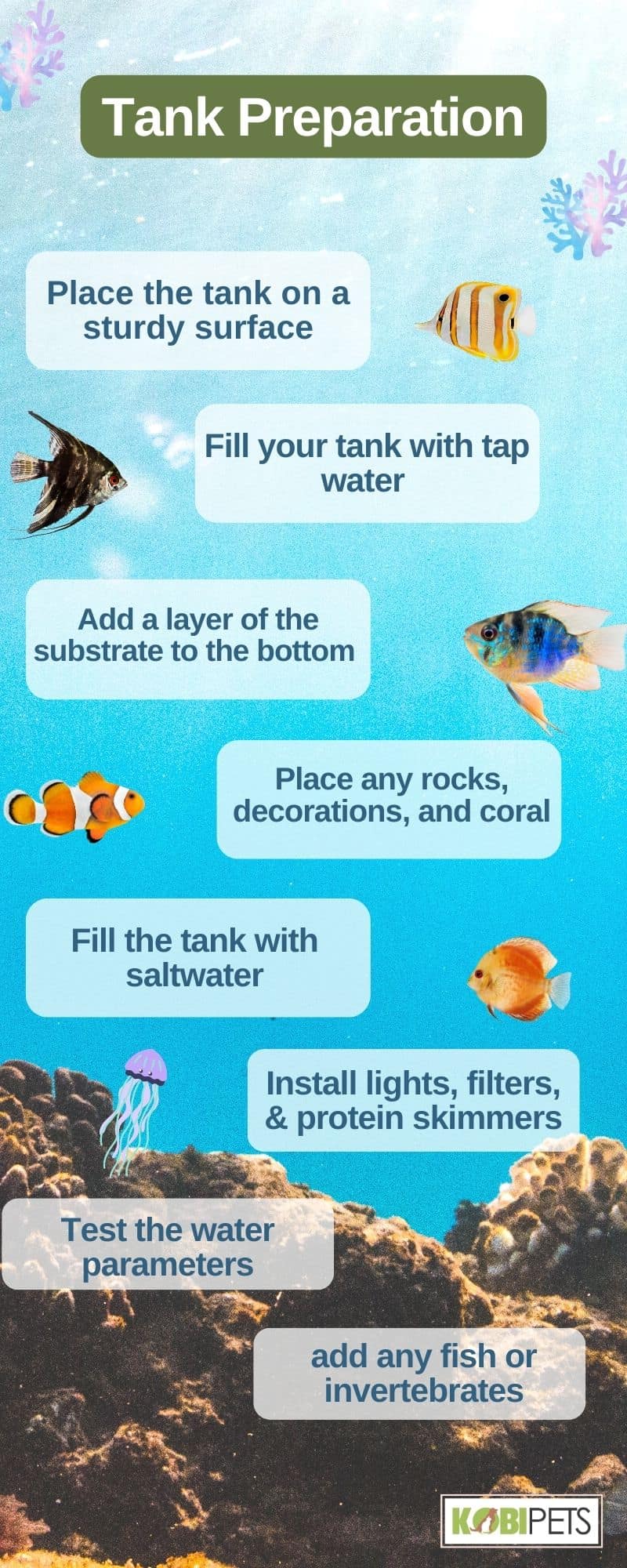
Tank Preparation
Here are the steps for setting up the tank and stand:
1. Place the tank on a sturdy surface or stand that can support its weight when filled with water. Make sure that the surface is level to ensure proper water circulation within the tank.
2. Fill your tank with tap water and let it sit for 24 hours before adding any fish or invertebrates. This allows time for the chlorine and other chemicals to evaporate from the water.
3. Add a layer of the substrate to the bottom of your tank. This will provide an aesthetically pleasing appearance as well as nutrients for beneficial bacteria and plant life in the tank.
4. Place any rocks, decorations, and coral skeletons into the tank before adding any water. This will help you create a natural-looking environment for your inhabitants.
5. Fill the tank with saltwater and let it sit for another 24 hours before adding any fish or invertebrates. This allows time for the salt to dissolve in the water and stabilize the pH level.
6. Install any additional equipment such as lights, filters, and protein skimmers. Make sure to follow the manufacturer’s instructions for proper installation.
7. Test the water parameters to make sure they are within the appropriate range for your inhabitants. Regular testing is essential in maintaining a healthy tank environment.
8. Finally, add any fish or invertebrates you plan on keeping in the tank. Make sure to acclimate them properly by following the directions in the acclimation guide.
By following these steps, you can create a beautiful saltwater aquarium that your family and friends will enjoy for years to come!
Water Preparation
Water preparation is essential in industrial, manufacturing, and agricultural applications, ranging from cleaning and washing to steam generation. Utilizing the correct water chemistry is an important factor in achieving optimal results for these purposes.
Many factors must be taken into consideration when preparing water, including its temperature, hardness, and alkalinity. In some cases, disinfection may also be required. Without taking into account all of these components, water treatment can be ineffective at best and cause damage to equipment or production efficiency at worst.
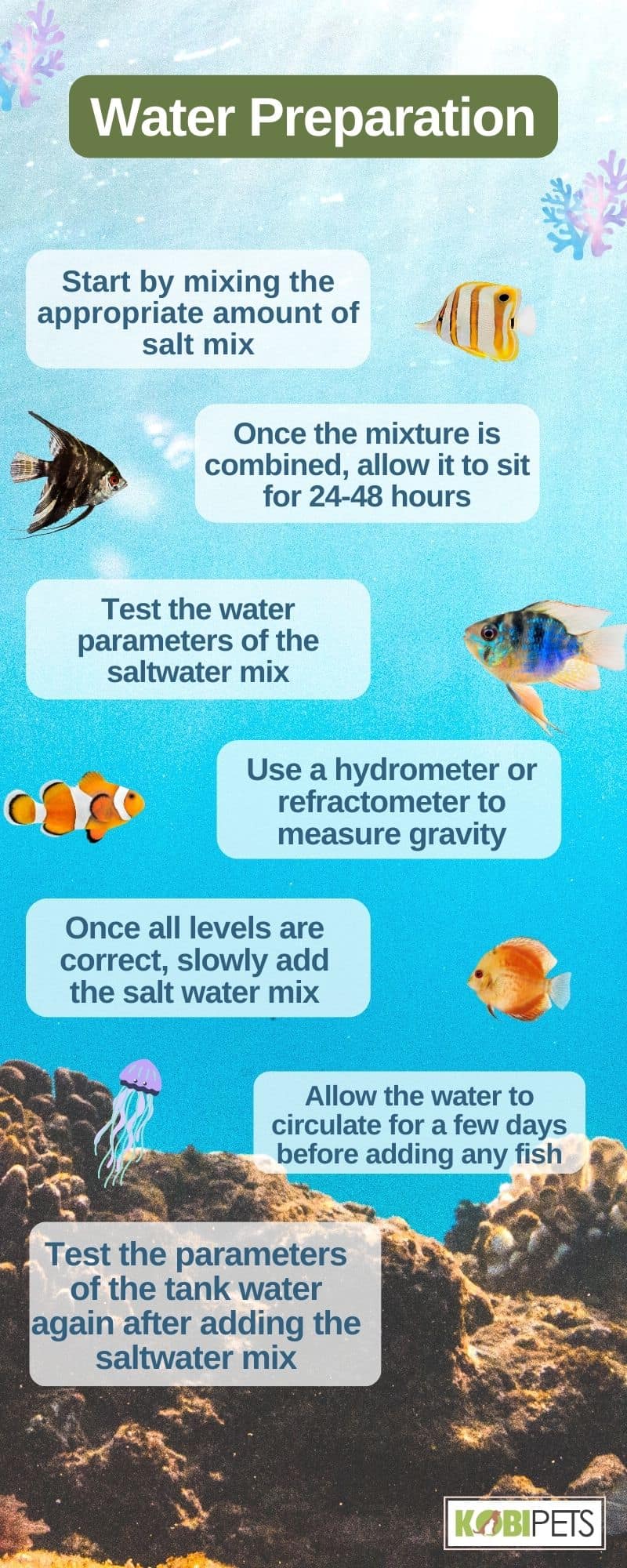
water Preparation
Here are the steps for preparing saltwater and adding it to the tank:
1. Start by mixing the appropriate amount of salt mix with water in a separate container. Make sure to follow the instructions on the package for the correct ratio of salt mix to water.
2. Once the mixture is thoroughly combined, allow it to sit for 24-48 hours so that chlorine and other chemicals can evaporate from the water.
3. Test the water parameters of the saltwater mix to make sure they are within the appropriate range for your inhabitants.
4. Use a hydrometer or refractometer to measure and adjust the specific gravity of the water to match that of your tank’s inhabitants.
5. Once all levels are correct, slowly add the salt water mix to your tank.
6. Allow the water to circulate for a few days before adding any fish or invertebrates. This allows time for the temperature and salinity levels to stabilize in the tank.
7. Test the parameters of the tank water again after adding the saltwater mix to ensure they are within the appropriate range.
By following these steps, you can prepare saltwater that is safe and suitable for your tank inhabitants. This will help create a healthy and thriving environment in which your fish and invertebrates can thrive!
Adding Livestock
Once the tank is set up and the water parameters are stabilized, it’s time to start adding livestock. Livestock refers to any fish or invertebrates that inhabit a saltwater aquarium. Before adding your livestock, it’s important to research them to make sure they will be compatible with your existing inhabitants, as some species may not get along.
When adding livestock to your tank, it’s important to take into account the size of the tank, as overcrowding can cause stress and aggression among fish. Additionally, make sure that you are introducing them slowly and gradually in order to avoid shocking the system or stressing out any existing inhabitants.
Here are the types of fish and invertebrates suitable for a beginner’s tank
- damselfish
- gobies
- clownfish
- royal grammar
- blennies
- dottybacks
- starfish
- sea anemones
- several species of shrimp.
These fish and invertebrates are usually hardy, easy to maintain, and can thrive in a beginner’s tank.
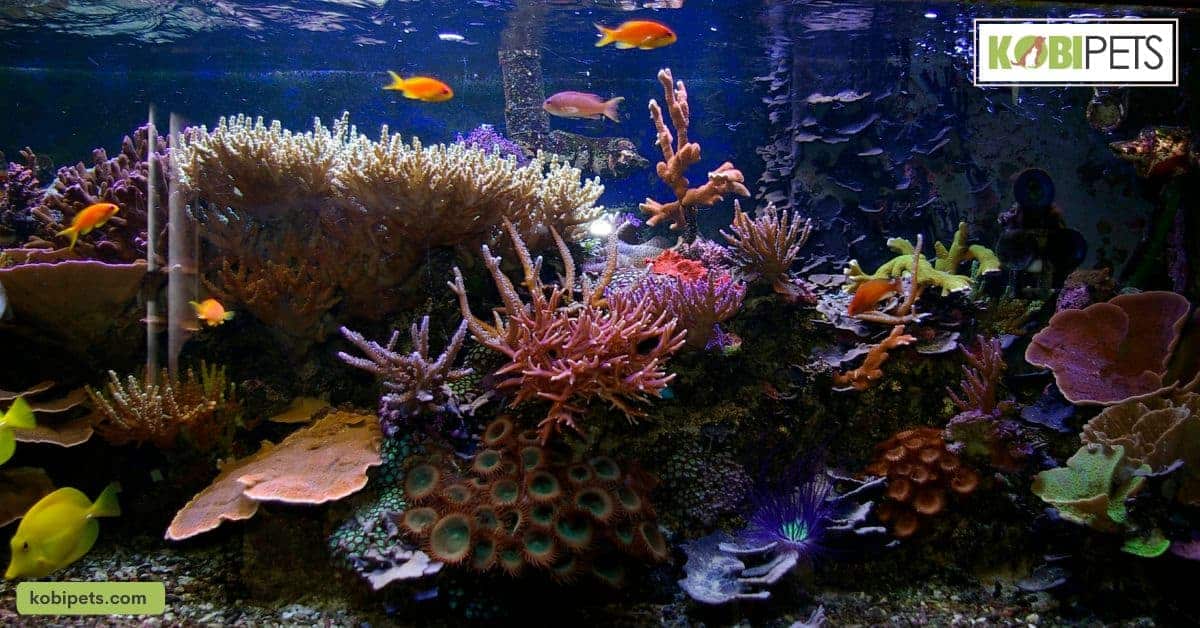
Maintenance and Upkeep
Once your tank is set up and running, there are several maintenance tasks that should be done regularly. These include doing water changes, testing water parameters, cleaning the filter, and inspecting for any signs of disease or damage. Doing these regularly will help ensure a healthy environment for your tank inhabitants.
- Water changes should be done every 2-4 weeks, depending on the size of your tank. This process involves removing 20-25% of the water and replacing it with clean saltwater. Doing this will help remove any unwanted pollutants or toxins that may have accumulated in the tank over time.
- It’s also important to test the water parameters regularly using test kits, as they provide an indication of the water’s quality and can help you adjust any parameters that are out of range. Additionally, make sure to clean the filter regularly to ensure it is functioning properly and not clogged with debris or dirt.
- Finally, inspect your tank daily for any signs of disease or damage. This includes looking at the fish and invertebrates for any signs of stress or illness, as well as checking the tank walls, decorations, rocks, and substrate for any damage or algae buildup.
Taking these steps will help maintain a healthy environment in your tank.
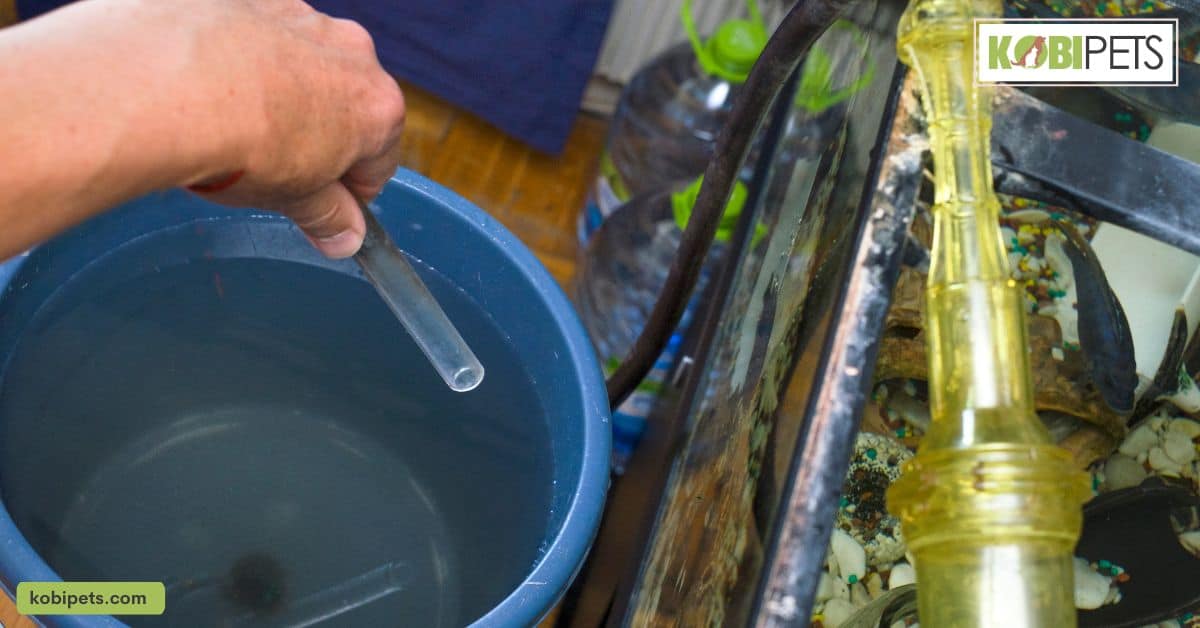
In Conclusion
A saltwater aquarium is an incredibly rewarding and fulfilling hobby that can bring beauty and life into any home. With the right knowledge and dedication, you can create a thriving environment for vibrant fish and invertebrates.
Setting up your tank correctly, preparing water correctly, and regularly performing maintenance tasks are essential steps to ensure the health of your saltwater aquarium. With the correct care and knowledge, you can create a beautiful underwater paradise that your family and friends will enjoy for years to come!


